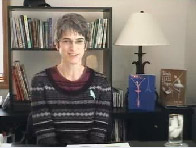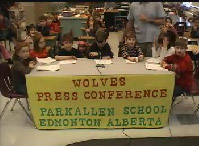Lit Review: This is a post in a series focusing on the research studies on videoconferencing.
Newman, D. L., Du, Y., Bose, M., & Bidjerano, T. (2006). A Content Analysis of Videoconference Integration Plans. Paper presented at the Society for Information Technology and Teacher Education International Conference, Orlando, FL.
Authors: Newman, Dianna L.; Du, Ying; Bose, Mohua; Bidjerano, Temi
Title of paper: A Content Analysis of Videoconference Integration Plans
Publication year: 2006
Database source: EdITLib
Name of journal: N/A
My Codes: VCContentProviders
Main Point: This study analyzed 46 lesson plans by teachers developed around content providers’ programs. These were part of the ProjectView grant that ended in 2005. The integration lesson plans are online here.
Theoretical Framework/References:
Several references are used to make the case that museusm already have educational content for schools, videoconferencing provides access to those resources, students participating in a videoconference engage in higher order thinking skills, and videoconferences enrich curriculum with an “active learning environment” and by “facilitating inquiry-based learning”. (p. 2). Two noteworthy references I hadn’t found already were Newman et. al 2004 and Silverman & Silverman 1999.
Methods, Sample, Variables/Case:
Content analysis was conducted on 46 lesson plans from New York State. The lesson plans were created by 63 teachers and educational consultants from 25 school districts. The lessons featured 26 content providers. A coding sheet was used to analyze the lessons. It’s included in the paper and has checkboxes for the various types of learning experiences and resources included in the lessons.
Findings:
The majority of the lesson emphasis (time) was on pre-conference preparation.
The most popular methods of instruction were the structured discussion/socratic method (65%). Next were lecture/direct instruction (46%), teacher demonstration (44%), and constructivism (43%). p. 4
Traditional modes of learning were used more leading up to the conference, and the student-centered constructive learning was used more after the videoconference.
The lower levels of Bloom’s taxonomy were used more in the pre-conference activities, and the higher levels of Bloom’s taxonomy were used more in the post-conference activities.
Rubrics, projects, and worksheets were the most popular assessment techniques used by the teachers.
Author/Audience: The authors are connected with the NYIT EEZ, which is a strong content provider support program in New York. The audience was the conference attendees, so people interested in educational technology and teacher education.
Questions/Thoughts/Implications:
Quotes: “The videoconference session may be considered as a catalyst for promoting higher levels of thinking during post videoconference sessions.” p. 5.
The videoconferences were used to “extend” and “enrich” the study. p. 5 But before you protest about those words, check this: students would be “exposed to richer alternative sources of information, real artifacts and animals, meet external experts, and get their questions answered.” And videoconferencing leads to “a more dynamic and interactive form of learning” p. 5.
This article emphasizes the importance of preparation for videoconferences, as well as essential component of wrap-around lessons to accompany videoconferences. Using a videoconference as a stand-alone “fun” activity is not appropriate! I really like the Project VIEW focus on teachers creating lessons to support their experiences with content providers.
Note to self: This is a great article for the week on preparing students in my online class, Planning Interactive Curriculum Connections.

 Students got to see both the draft of the writing as well as the draft of the drawings. This ASK program was unique in that Amy Young is both the author and the illustrator, so students could see the process from both perspectives.
Students got to see both the draft of the writing as well as the draft of the drawings. This ASK program was unique in that Amy Young is both the author and the illustrator, so students could see the process from both perspectives. Amy also had a pair of Belinda’s shoes, which was really cool! The students were very impressed.
Amy also had a pair of Belinda’s shoes, which was really cool! The students were very impressed.

 Today I have two classes participating in
Today I have two classes participating in  There were 8 interactive schools, but the majority of the session was questions, so we were able to ask about 4 questions.
There were 8 interactive schools, but the majority of the session was questions, so we were able to ask about 4 questions. What I noticed this time was the intentional instruction before the Q&A time. How many young students have you seen flounder when offered a chance to ask questions?! They don’t know the difference between a question and a statement. So they try to tell the presenter a story or something that they know, often off topic.
What I noticed this time was the intentional instruction before the Q&A time. How many young students have you seen flounder when offered a chance to ask questions?! They don’t know the difference between a question and a statement. So they try to tell the presenter a story or something that they know, often off topic. It’s the third day of Read Around the Planet, and so I thought I’d write a bit about how it’s going in our little corner of Michigan. I have 72 RAP connections, but it doesn’t beat Amy Yager’s 125! Aren’t we all crazy!?
It’s the third day of Read Around the Planet, and so I thought I’d write a bit about how it’s going in our little corner of Michigan. I have 72 RAP connections, but it doesn’t beat Amy Yager’s 125! Aren’t we all crazy!?

 This week I’ve been facilitating three Point-to-Point MysteryQuests for Reed Middle School in Bridgman, MI. They connected to MO, NJ, and CA. It’s our first time running MysteryQuests in just an hour with just one other school. The time frame better fits the traditional middle school schedule and makes it easier for the teachers to schedule and participate. We did one each day so that they weren’t scheduled back to back.
This week I’ve been facilitating three Point-to-Point MysteryQuests for Reed Middle School in Bridgman, MI. They connected to MO, NJ, and CA. It’s our first time running MysteryQuests in just an hour with just one other school. The time frame better fits the traditional middle school schedule and makes it easier for the teachers to schedule and participate. We did one each day so that they weren’t scheduled back to back.